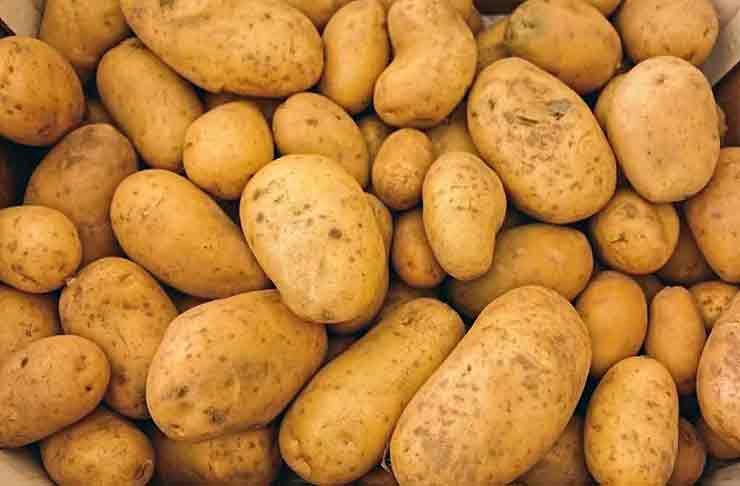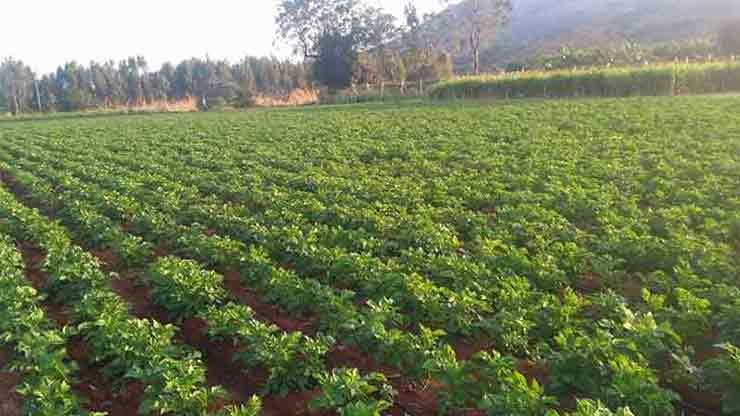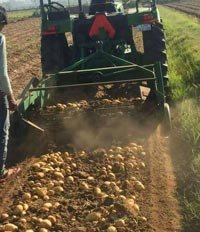Potato farming guide for beginners. Potato crop is one of the most profitable short-term agriculture crop. Potato growing is a good, viable business and one can make a huge profit from potato cultivation. Learn how to grow potatoes in India.
Potatoes are a favorite regular on the Indian dinner table. Most families cook potatoes for their food. They are as regular as wheat or rice. Therefore, cultivating potatoes is a good, viable business. The word ‘potato’ actually refers to the tuber which is the edible part of potato plant. Sometimes, the whole plant is also referred to as potato. It is a very important staple food in most parts of the world since it is rich in carbohydrates. The global annual potato production is more than that of all vegetables. Owing to this high demand of potatoes, farmers look upon it as a profitable business. In addition, it serves as a good point to break the crop rotation from grass.
Information on Potato

Botanically called Solanum tuberosum potatoes fall under family Solanaceae. Potatoes are few of the tuber-bearing plants belonging to this family. The potato plants are annuals attaining a height of maximum 2 feet. They propagate through underground tubers. The buds on the tubers develop into leaves and stems. The flowers maybe pink, red, white, purple or blue flowers bearing yellow stamens. The fruits borne by the plant after flowering are small and green in color. They resemble cherry tomatoes. Each fruit has at least 300 seeds in them. Tubers are the only edible part of this plant since other plant parts contain the alkaloid toxin called solanine. Hence except tubers, no other plant part is suitable for consumption.
Ideal Conditions for Potato Cultivation
Climate and Temperature for Potato Farming

Being a cool season crop, the best place for potato farming are places with a cool climate, fertile soil and good moisture. Temperature, light, soil type, moisture content and nutrients influence the growth of potatoes in a great way. Tubers stop developing at a temperature above 30⁰C. This is because, as the temperature increases, the rate of respiration increases. In the process, carbohydrates produced through photosynthesis get consumed instead of getting stored in the tubers. Thus, tuber formation gets affected at higher temperature. Soil temperature of 17-19⁰C is ideal for potato tuber formation. Bright sunshine during day and cool nights are optimal for potato growing.
Season for Potato Farming
Being a rabi season crop, it is usually cultivated during the months from October to December. This is the time when the weather is neither hot nor cold. Since the monsoons are nearly over at this time, it is an ideal time for cultivating potato crop.
Soil for Potato Cultivation
Potato tubers require ample amount of air and water. In addition they need space underground to expand and swell in size as they grow. Therefore, a loose, loamy soil is optimal. Clayey soil keeps the water and air from reaching the roots. In addition, since they stick a lot the tuber growth gets restricted.
pH Required for Potato Growing
Soil pH must be maintained between 4.8 and 5.4. It is on a slightly acidic side to promote carbohydrate formation and storage in tubers.
Water for Potato Farming

For potato, the daily crop water requirement is 4-5mm a day. For a better yield, irrigation must be done immediately after sowing. This allows for proper seed germination. The irrigation frequency varies with the place. For example, it is irrigated once a week in Punjab since the tuberization period coincides with the cool weather and thus low evaporative rate in the place. On an average, they need 4-5 mm water per day- just enough to maintain the moisture level, temperature and thus promote uniform tuber formation. The last lot of irrigation is done about fifteen days prior to harvesting. This promotes hardening of tuber skin before harvesting potatoes.
Crop Rotation with Potatoes
Solanaceous crops extract a lot of nutrients from soil. Therefore, potato, a Solanaceous crop must be rotated with non-Solanaceous crops like maize, paddy, etc.
Planting Material for Potato Farming

Mini tubers whole or cut are used as planting materials. Larger seed potatoes are generally cut down into multiple pieces. Each tuber however must contain eyes for development of the plant.
In India, there are different varieties of potatoes bred and newly introduced that are used commercially for growing potato crops. Some of these can be enumerated as:
| Variety | Characteristics | Places Suitable for Cultivation |
|---|---|---|
| Kufri Sindhuri |
| North Indian plains |
| Kufri Chandramukhi |
|
|
| Kufri Khasi-Garo |
| North Eastern parts |
| Kufri Chamatkar |
|
|
| Kufri Sheetman |
| North Indian Plains |
| Kufri Jyoti |
|
|
| Kufri Alankar |
| North Indian plains |
| Kufri Jeewan |
| Plains of North India |
Land Preparation for Potato Farming

Slightly acidic, loose soil is optimum for potatoes. Therefore, the land must be ploughed well 2-3 times and then harrowed. This ensures good tilth and clod-free seedbed. All the hard pans and rocks must be destroyed during the land preparation stage. Presence of hard pan can interfere with water and air circulation for the tubers which would in turn affect the potato growth. The beds must be prepared keeping a distance of 60-90 cm between the beds and the intra-bed distance must be about 45 cm.
Potato Planting
While planting, the soil temperature must not be beyond 16⁰C and the planting depth must be 5 to 10cm. There are two very important points that must be considered while planting.
Seeding Material
The seed material must be procured from reliable sources. It is advisable to approach the local government agricultural body for this purpose. The tubers must be well-sprouted and must weigh about 50-60g in size. The seeds must be treated with 0.3% mancozeb before sowing. This is to avoid soil and tuber borne diseases.
Potato Planting Time
This is another important factor in case of potato cultivation. The planting time for potato is different for different parts of India.
In the central plains of India such as Madhya Pradesh, Gujarat and Orissa, potato is a winter or rabi crop. Therefore, the time of planting here is during the months of October and November.
Potato can be both kharif and rabi crop in the Deccan plateau, i.e., in states like Andhra Pradesh, Karnataka and Maharashtra. In other words, two crops of potatoes can be grown in these regions- from mid-June to mid-July and then during October and November.
In the southern plains, potatoes are grown throughout the year during summer, autumn and spring. In other words, they are cultivated during April/May, August/September and January.
Weed Management in Potato Cultivation
For a good harvest, weed management is critical. Weeds compete with the plants for water, light and nutrient thereby affecting the tuber development and yield. The initial 4-6 weeks are the critical weed management period. Soil solarization, efficient crop rotation, maintaining optimum plant population, inter-cultivation, manual weeding and applying herbicides at appropriate intervals are some of the measures followed. Some of the herbicides recommended are metribuzin and alachlor in the pre-emergence period and parguat and propanil in the post-emergence period.
Diseases and Plant Protection in Potato Farming
Late Blight
Causative Agent
Phytophthora infestans
Nature of Damage
This disease sets in once the foliage has developed fairly well. The diseased tubers decay before harvest.
Symptoms
- Infection begins at the lower leaves with presence of water-soaked lesions towards margins
- The lesions enlarge in case of favorable humidity and temperature
- Whitish cottony growth can be observed on the lower side of the leaves in humid places.
- Infected leaves begin to rot and turn black in color.
- Infected decaying leaves emit pungent odor.
- Stems also begin rotting
- Infected tubers exhibit greenish sunken areas.
Control
- The seed tubers used for cultivation must be chosen from disease-free areas.
- The infected plant must be destroyed as soon as it is detected.
- Resistant varieties like Kufri Navtal can help control the disease.
- Spraying fungicides are effective if they are used in time. Dithane M-45 or Z-78 must be used for spraying and it must be repeated every 10 days.
Early Blight
Causative Agent
Alternaria solani
Nature of Damage
This is a more common disease affecting the potato crop. It can occur at any stage of growth in potato farming.
Symptoms
- Leaves develop spots in the concentric rings ranging in color from brown to black.
- The spots are scattered all over the leaves.
- Infected leaves fall off and the infection spreads to stems.
Control
Burning the crop debris after harvest is the most effective way of controlling the disease. But, this method cause air pollution.
Black Scurf
Causative Agent
Rhizoctonia solani
Nature of Damage
This disease occurs in two phases and cause cankers leading to wilting of potato plants.
Symptoms
- Delayed germination since the sprouts get killed even before they emerge. This phase is called stem canker phase.
- Tubers have a black crust on them that makes them unacceptable in the market.
Control Measures
- Healthy, clear tubers must be chosen for potato planting.
- Dipping the seed tuber in Agallol (0.5%) for 10 minutes before sowing would help check the disease.
- Treat the soil with 10-12 Kg Brassicol per acre is another preventive measure.
- Pre-treatment of soil and seeds is the best way to control the disease.
Brown Rot
Causative Agent
Pseudomonas solanacearum
Nature of Damage
This is a type of bacterial wilt caused by the Pseudomonas solanacearum which is a soil bacterium. It is most common in plateau regions and in West Bengal.
Symptoms
- Sudden, unexplained wilting of the plant is the most common symptom.
- The affected plants droop down while the affected branches turn brown.
- Eyes of the tubers blacken.
Control
- Disease free, certified seeds must be used for potato farming.
- While using tubers for sowing, they must be stored at 12⁰C for 4-5 days so that the cut surfaces harden.
- Treat the tubers with Agallol solution before sowing.
- After harvest, the crop debris must be burnt.
Wart Disease
Causative Agent
Synchytrium endobioticum
Nature of Damage
This disease is prevalent in Darjeeling and surrounding hills. In severe cases, the tubers get converted to clumps of distorted mass.
Symptoms
Warts and tumors appear on the stems and tubers of the potato plant.
Control
Since the disease is prevalent in the hills and north eastern areas, immune varieties are available which must be planted. At the time of planting, care must be taken to avoid wart affected tubers.
Mosaic
Causative Agent
Mosaic Virus
Nature of Damage
Plants affected by mosaic disease remain stunted in growth. The tuber size is also affected by the virus.
Symptoms
- Dark green and green mosaic pattern on leaves
- Some leaves show yellow patterns
- Disease spreads from sick to healthy plants through insects.
Control
The tubers for sowing must be healthy and certified. The field must be monitored constantly and any plant showing the symptoms must be immediately destroyed. Spraying the crop with Rogor (280 mL dissolved in 250 litres of water per acre) every 15 days would also keep the viral infection at bay.
Leaf Roll
Causative Agent
Potato Leafroll Virus
Nature of Damage
As the name suggests, the leaves of the plant roll from the margins to the mid-rib. The tuber size gets reduced greatly. This disease is very common in the plains.
Symptoms
- Leaves roll towards the mid-rib till the entire lamina is involved.
- Leaves have a leathery texture and produce a rattling sound when touched.
Control
The control measures for both leaf roll and mosaic disease is the same.
Pests Affecting Potatoes
Numerous insect pests attack potatoes affecting the yield and quality of tubers. Some of the major ones are:
| Name of the Pest | Nature of Damage | Identification | Control |
|---|---|---|---|
| Epilachna Beetle |
|
| Spraying 0.2% sevin is effective. |
| Cutworms |
| These worms remain hidden during day and affect the crop at night |
|
| Aphids |
|
| Applying Rogor EC (240 mL in 400 Litres water per acre). |
| Leaf Hoppers |
| Adults and nymphs have piercing type of mouthparts. | Carbofuran at the time of sowing can control leafhoppers. |
| White Grub |
| The larvae are generally vary in color from white to cream. They possess a pair of suckers. | Carbofuran at the time of sowing would check the disease. |
| Potato Tuber Moth |
| A full-grown adult moth is yellowish in color with orange colored eyes. |
|
Harvesting and Curing of Potato

The harvesting time of potato is usually dependent on the weather and market prospects. In case of high demand in the market, harvesting is done slightly early. Irrigation of the plants is stopped at least a week before harvesting potatoes. Harvesting is done once the soil is completely dry. Some farmers kill the vines using Gramoxone Extra. This ensures a good skin set for the tubers. The treatment is done a week before harvesting. In order to avoid bruising or any other damage to the tubers, they are carefully dug using potato digger manually. There is no universal time for harvesting potatoes. The schedule for harvest according to the place of cultivation is as below:
| Region | Crop | Planting | Harvesting |
|---|---|---|---|
| North Western hilly region | Summer | Jan-Feb | July-Aug |
| North-eastern hilly region | Summer | March-April | Sept-Oct |
| Southern hills | Summer | March-April | Aug-Sept |
| Autumn | Aug-Sept | Dec-January | |
| Spring | Jan-Feb | May-June | |
| Northern Plains | Autumn | Sept-Oct | Dec-January |
| Winter | Oct-Nov | Feb-March | |
| Spring | Dec-Jan | March-April | |
| Plateau | Kharif | June | Sept-Oct |
| Rabi | Oct-Nov | Feb-March |
After digging the tubers, they are washed and cleaned under running water. Then they are graded according to size, packed and stored.

Potato Seed Storage
Seed potatoes are stored at 2-4⁰C with 95% relative humidity until the next sowing season. Some farmers pre-treat them with chemicals in order to avoid infection by pests, nematodes and insects.
Conclusion
Potato is in high demand in the Indian markets. They are very popular in the Indian cuisine. Potatoes are almost as staple as wheat and rice in India. The consumption of potato, as per statistics, has increased by 850% during the period from 1960s to 2000s. Apart from being a staple diet, it is cash crop that provides farmers with a significant amount of income. One can make a huge profit from potato farming.
Reference
- http://agritech.tnau.ac.in/org_farm/orgfarm_potato.html
- https://www.potatopro.com/india/potato-statistics
- http://www.envfor.nic.in/divisions/csurv/geac/Biology_of_Solanum_tuberosum_Potato.pdf
- http://www.ikisan.com/tg-potato-water-management.html
- http://www.krishisewa.com/articles/production-technology/316-potato-production.html
- http://www.ikisan.com/ka-potato-varieties.html
- https://www.potatopro.com/india/potato-statistics
Nice information…l also want to plant patato.. where will I get the seeds?
I am resident of dist Kannauj, utterpradesh. What seed of Potato suitable for me
I’m in South Africa and I would also like to plant potatoes, when can I get seeds